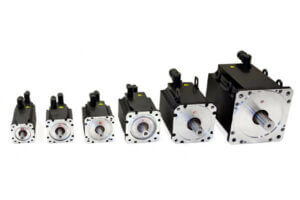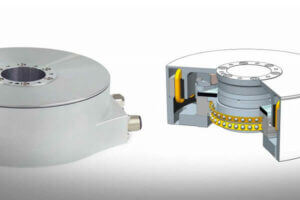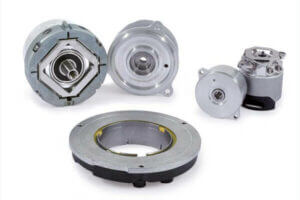April 22, 2019
Servo motors for CNC machines
- For advanced industrial machines with high precision, speed and torque requirements, servo motors are better suited than stepper motors.
- Servo motor advantages include better torque maintenance, higher resolution movement with encoders, and a broader range of configurations/sizes to match the load inertia ratio.
- Quality parts begin with the selection of the right motor; servo motors allow for precise movement and feedback ideal for multi-axis machinery and intricate part geometries.
- The addition of a dedicated measuring device gives servo motors the advantage when it comes to accuracy and precision.
Machine tool operators interact directly with the control, tooling and work envelope, but rarely do they handle or even see a machine tool’s feed motors. Yet, it’s one of, if not the most important piece of equipment for producing quality parts. A perfect code, dialed-in offsets, high-performance tooling–none of it matters if the motor is not able to consistently and accurately feed the part and/or the spindle. The motor’s action impacts everything from surface finish and tool life to scrap and process efficiency.
Common Types of Motors used in CNC Machines
The two motors most often used in CNC machine tools are stepper motors and servo motors. Both work to convert a non-linear input from the control into linear movement at the spindle shaft and table by turning a screw-like shaft to move the load.

How a Stepper Motor Works
Stepper motors use equally sized steps positioned around a cylinder. In machine tool applications, there are often 200 steps, or magnetic poles, in a full rotation, i.e. 100 steps for 180 degrees of rotation. Depending on the size of the motor, a known voltage is established and applied to turn one step. Some are also capable of micro steps where each step is broken down into smaller steps, allowing for higher resolution movement.
Stepper motors operate on an open loop, meaning that their position is dictated exclusively by the voltage they receive; there are no sensors providing location or relative motion measurements to the control. Their relatively simple assembly makes them a reliable choice when matched with the right application.
How a Servo Motor Works
Servo motors, also known as axis or torque motors, use fewer electromagnetic poles—usually fewer than a dozen—and rely on closed-loop communication for accuracy and speed control, meaning there is a two-way signal between it and the control. In other words, when powered on, the control receives an exact positioning signal. There’s no need to reestablish zero. Rotary or angle encoders are the primary feedback devices used to facilitate this back and forth.
With servo motor assemblies, there’s the option to pick and choose the motor and feedback device pairing that’s specific to product or budget. For high-precision metalworking machinery, motors are also available with the ideal encoders already integrated.

Comparing Stepper and Servo Motors
Because of the fundamental differences in how they function, servo and stepper motors have different strengths and weaknesses. Generally speaking, servo motors are suited for advanced industrial machines with high precision, speed and torque requirements, while stepper motors are used in less demanding workhorse shop machines and by hobbyists.
Cost
The addition of the feedback device and other requisite hardware makes servo motors more expensive than stepper motors. However, the ability to mix and match the motor and encoder assembly does offer flexibility.
Torque
Stepper motor torque decreases with rapid acceleration and at high speeds. Thanks in part to the powerful rare earth magnets they employ, servo motors maintain nearly all their torque at maximum speed, which also translates to higher efficiency. Some servo motors are also capable of nearly doubling their rated torque for short periods, which can be extremely useful for stopping, starting and reversing tables or spindles.
Note: There are various torque specifications for servo motors. The commonly accepted specification for machine tool applications is rated torque.
Durability
A servo motor has parts that a stepper does not, like the feedback device, brushes that transmit power and, in some instances, gearboxes, resulting in slightly higher risk for failure than a stepper motor.

Repeatability and Accuracy
The addition of a dedicated measuring device gives a servo motor the advantage. Extreme resolution, on the order of hundreds of thousands of steps per revolution, allows for precise movement that’s especially crucial as more axes are added to machine centers. Stepper motors also can occasionally “miss” steps, a small error that won’t be recognized by the control but may be seen on the part.
Speed
Servo motors are capable of maintaining peak performance at very high speeds, several thousand RPMs as opposed to about 2,000 on stepper motors. This makes servo motors popular for high-speed machining (HSM) equipment that’s gaining popularity in the world of manufacturing. This extra speed is often necessary for precision cutting, finishing operations and work with tougher materials.
Why Servo Motors are Used in CNC Machines
Quality parts start with the machine tool’s motor. Servo motors are the choice for axes motion control in machine tools built for high-speed, high-precision work. Factors like superior torque, high-resolution movement and feedback, and stability help avoid results like poor surface finish, accelerated tool wear and out-of-spec contouring.
1. The Ability to Use Encoders
Rotary and angle encoders for servo drives provide detailed and precision feedback to the control with thousands of times higher resolution than what’s possible with stepper motors. Absolute and incremental-style encoders both not only allow for the precise control motion and speed that’s required of today’s multi-axis machinery and intricate part geometries, they provide operators with better visibility to how the operation is performing.
These encoders are easy to mount and wire, are short in overall length and can even account for safety functions like those handled by limit switches.
2. Superior Load Control
Servo motors are available in a wide range of configurations, sizes and capabilities. This makes it possible to find the ideal rigidity match for the size and load of any machine tool. This is important because the inertia ratio between the motor and the load is critical to maintaining position accuracy during reversals and resisting vibration in heavy cutting milling applications; servo motors give machine tool builders the chance to match the largest possible motor with the lightest possible table.
3. Managed Acceleration
When it comes to accelerating a table or spindle, the relationship between torque and inertia in the motor itself is a critical one. Because of their superior capabilities, servo motors offer more combinations of torque and the motor’s own inertia that allow builders to dial in acceleration capabilities as needed.
4. Controlled Torque Ripple
Servo motors that are optimized for machine tools limit the disturbances they themselves can introduce into a machining operation. Motor torque invariably fluctuates during a revolution of the shaft, but the right servo motor can limit the influence this has on the part, namely contouring errors and shaded finishes.
Conclusion
Stepper motors and servo motors both have their place in the world of CNC machine tool design. Servo motors, however, offer more options in terms of capabilities and hardware. These highly capable motors will only become more valuable to the overall effectiveness of a machine tool as manufacturing advances toward more unmonitored production and parts continue to shrink in size and grow in complexity.
If you want to take a deeper dive on this, or any other motion control topic, we make our experts available. Schedule a consultation now to start finding specific solutions to your challenges.

